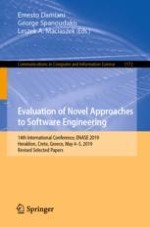This book constitutes the refereed proceedings of the 14th International Conference on Evaluation of Novel Approaches to Software Engineering, ENASE 2019, held in Heraklion, Crete, Greece, in May 2019.
The 19 revised full papers presented were carefully reviewed and selected from 102 submissions. The papers included in this book contribute to the understanding of relevant trends of current research on novel approaches to software engineering for the development and maintenance of systems and applications, specically with relation to: model-driven software engineering, requirements engineering, empirical software engineering, service-oriented software engineering, business process management and engineering, knowledge management and engineering, reverse software engineering, software process improvement, software change and configuration management, software metrics, software patterns and refactoring, application integration, software architecture, cloud computing, and formal methods.
